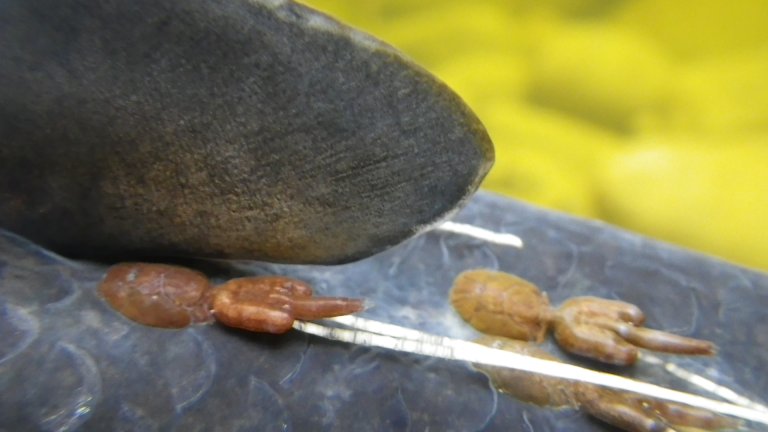
Salmon lice are a notifiable parasite in Norway (Category F). All occurrences of salmon lice in aquaculture facilities must be reported weekly to the Norwegian Food Safety Authority, in accordance with the “Regulation on the Control of Salmon Lice in Aquaculture Facilities.”
Pathogen and Transmission
Salmon lice are a type of sea lice, crustaceans belonging to the Caligidae family. Several related species exist, but the dominant species affecting salmon and trout in Norway is the salmon louse, Lepeophtheirus salmonis. Another member of the Caligidae family, Caligus elongatus, also attaches to salmonids.
Salmon lice grow by molting their exoskeleton. Mating occurs on the host fish, after which the fertilised eggs are released into two long egg strings attached to the female’s genital segment. Over its lifetime, a female can produce at least 11 pairs of egg strings, each containing several hundred eggs.
The eggs hatch into the first of three free-swimming larval stages: nauplius 1. This stage progresses to nauplius 2 and then to the copepodid stage, which actively seeks out and infects a fish. These free-swimming stages can last several weeks in cold water, allowing the lice to spread over long distances.
The next stages, chalimus 1 and 2, attach to the fish using a filament anchored to its skin. The preadult 1 and 2 stages, as well as the adults, move freely on the fish and cause the most harm.
Clinical Signs
Salmon lice consume skin, mucus, and blood. The severity of damage depends on the number of parasites, the size of the host, and its general health. A high louse load can lead to significant wounds, disrupt salt balance, and cause secondary infections. In severe cases, louse infestations can be fatal.
Diagnosis
Fish farms are required to count lice on a random sample of fish weekly (every other week if temperatures are below 4 °C). Counts are typically performed manually, but the Food Safety Authority has authorised alternative non-manual methods using cameras and image analysis.
Occurrence
Salmon louse infestation pressure increases with fish density. Higher louse prevalence is found in areas with large biomass of farmed fish. Salmon farming provides lice with more hosts, which in turn raises infestation pressure for farmed and wild fish.
Salmon louse development is temperature-dependent, and higher sea temperatures lead to increased infestation pressure. Even a low number of lice per farmed fish can result in a large overall parasite load, posing a significant threat to wild salmonids.
Surveillance
A national surveillance program led by the Food Safety Authority and coordinated by the Norwegian Veterinary Institute began in 2013. It aimed to evaluate the effectiveness of louse treatments and provide advice on the use of medications in aquaculture. In 2019, freshwater resistance was added to the program to assess differences in resistance between regions with high and low freshwater use. The program ended in 2023.
Wild salmonid populations are monitored annually to assess the risk that lice from fish farms pose to wild stocks of salmon and sea trout. This impact is a key indicator in the so-called “Traffic Light System,” which regulates the production capacity of aquaculture in various coastal zones in Norway. The impact assessment combines surveillance data with modelling, including the Veterinary Institute’s risk model for louse-induced wild salmon mortality.
Control Measures
Regulations set clear limits on the number of lice allowed per fish in aquaculture. Control measures must be implemented to ensure these thresholds are not exceeded.
While medications were historically the primary control method, non-medicinal approaches are now more commonly used for both prevention and treatment.
In aquaculture, treatment may involve drugs administered via feed (e.g., emamectin benzoate, flubenzurones) or as baths (e.g., pyrethroids, azamethiphos, hydrogen peroxide). Bath treatments involve either covering the pen with a tarpaulin or transferring the fish to a wellboat with a closed treatment system.
If lice in a population are repeatedly exposed to a treatment, those with higher tolerance may survive and reproduce, passing on resistance genes. This leads to selection for drug resistance. In Norway, resistance to several approved lice treatments is now widespread.
Various non-medicinal control methods have been adopted. The most common include removal of lice using heated water, freshwater, or mechanical brushing or flushing. These methods involve crowding and handling the fish and have been linked to reduced fish welfare, increased bacterial infections (such as pasteurellosis), and higher mortality. Another non-medicinal strategy is the use of cleaner fish, which eat lice off the salmon. Wild-caught wrasse and farmed ballan wrasse and lumpfish are commonly used. Cleaner fish should generally be removed before louse treatments to ensure their welfare. The use of cleaner fish has declined in recent years.
Other approaches include physical barriers like skirts, submerged or closed cages, current barriers, as well as specialised feed and selective breeding. Laser technology is also being used to target lice. Reducing the time fish spent in open sea cages—by growing the fish larger before stocking—can also lower lice exposure. Coordinated fallowing and production periods across geographic zones can temporarily reduce louse numbers but may increase louse problems in the second production year compared to uncoordinated operations.
